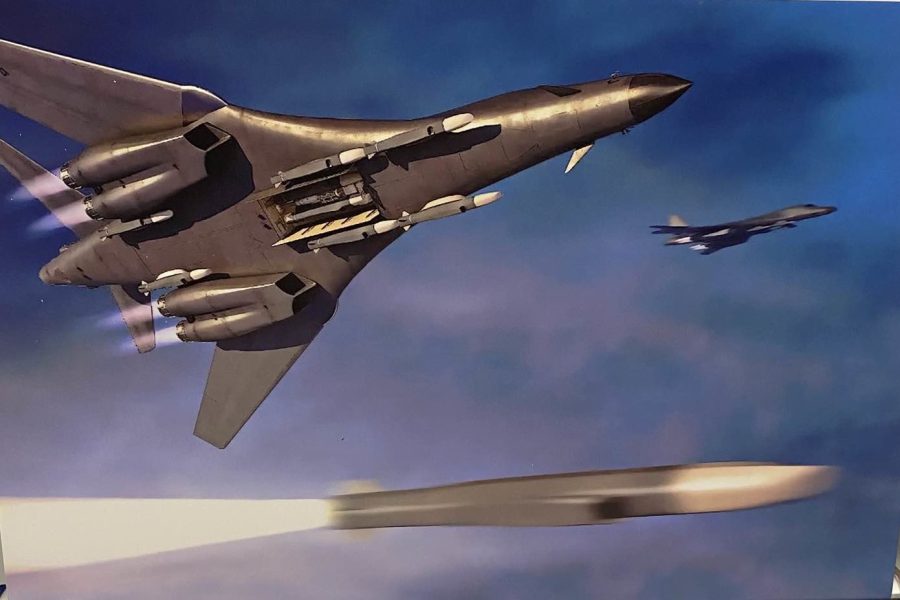The Air Force plans to add external weapons pylons on the B-1B bomber, both to increase the number of aircraft that can test hypersonic missiles and expand the Lancer’s loadout as USAF transitions to the B-21 bomber, according to service budget documents and contractor Boeing.
The fiscal 2026 budget request includes $50.26 million for a new effort called the “External Heavy-Stores Pylon program,” which will provide “increased carriage capacity of standoff munitions on B-1B aircraft.” This “increased volume of fires” off the B-1B can be done in the near term, the documents state.
By expanding the number of existing standoff weapons the B-1B can carry—such as the AGM-158 Joint Air-to-Surface Standoff Missile and its stablemate, the Long-Range Anti-Ship Missile (LRASM)—the Air Force says it can “mitigate transition risk of the Air Force bomber fleet prior to the emergence of the B-21 as a combat bomber.”
In other words, the Air Force wants to give the B-1B more shots per sortie in part to account for any delays as the B-21 enters the fleet.
The B-1 already has six external hardpoints, which were originally intended to carry two nuclear-armed AGM-86B Air-Launched Cruise Missiles, but they were deactivated under arms control treaties with Russia; those agreements saw the B-1 removed from nuclear delivery missions. The Air Force is now looking to reopen those weapon stations, each of which the service said should be capable of carrying a 5,000-pound payload.
One external station on the B-1B was already reopened to permit it to carry the Sniper laser electro-optical targeting pod.
For fiscal 2026, the Air Force plans to conduct computational fluid dynamics and wind tunnel testing of various external pylon/weapon configurations and begin the design of needed hardware changes. The service will also start software work to tie the new pylons in with the Lancer’s stores management system.
Two years ago, Boeing revealed the Load Adaptable Modular pylon, which could allow the B-1 to carry additional weapons on external stations. The company promoted the idea of using the B-1 for hypersonics testing, arguing that B-52 fleet already has enough testing to be done in the next seven years, given various programs to give it new radar, engines, communications gear, and other upgrades. Boeing said the B-52 program could offload some or all hypersonic testing to the B-1, given the right external capability.
Part of the 2026 B-1B budget documents note that USAF spent $20 million over fiscal years ’22 and ’23 to develop “an external carry-enabled testbed facilitating rapid integration of priority hypersonic weapons in support of national security objectives” and this created the “opportunity” to increase the B-1’s loadout.
“This program provides an opportunity to significantly reduce risk for an operational external carry capability on the B-1B if directed. The Hypersonic Integration Program successfully demonstrated the B-1’s ability to execute a captive carry of a 5,000-pound class store and the release of a proven weapon shape from a Load Adaptable Modular (LAM) pylon,” the document states.
One of those “opportunities” is the LRASM. Adding the LRASM to the B-1 “addresses an air-launch capability gap” by providing “flexible, long-range, advanced, anti-surface capability against high-threat maritime targets.”
The documents stated that procurement of the latest version of the LRASM will start near the end of fiscal 2027 and continue “until the missile inventory objective is met.”
According to an in-house Boeing newsletter, addition of the LAM could allow the B-1 to “increase 50 percent of its current weapons payload capacity with larger and heavier weapons.” It said each of the six pylons can carry two 2,000-pound weapons or one 5,000-pound weapon. The system was developed under independent research and development, and the company said it “saved over two years of development time, speeding increased combat capability to the flight line.”
With the new pylons, the B-1’s loadout of JASSM or LRASM could increase from 24 missiles internally to 36 in a mix of internal and external hardpoints.
The Air Force has at least two air-launched hypersonic missiles in development. It initially said it was shelving the AGM-183 Air-Launched Rapid Response Weapon (ARRW)—a boost-glide hypersonic system—after mixed results in testing, but ARRW is back in the 2026 budget. The service is also pursuing the smaller Hypersonic Attack Cruise Missile (HACM), an air-breathing missile small enough to be launched from fighters. When Boeing first unveiled the LAM to reporters in 2023, it said the pylon could likely carry up to 7,500 pounds, which would allow it to carry the ARRW, the weight of which is estimated to be around 6,500 pounds. It’s not clear if the budget language specifying 5,000 pounds is the result of test results.
The LAM continues in testing under the 412th Test Wing at Edwards Air Force Base, Calif., which has demonstrated the pylon with inert munitions.


